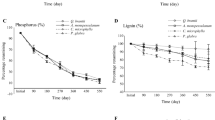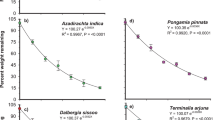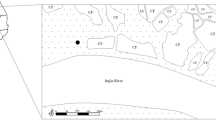Abstract
Wild plant species are crucial component for ecosystem stability and also affecting the nutrient dynamics of the system. However, there are relatively few experimental tests to assess their litter availability (biomass) and quality. In the present study, the litter potential and their quality plasticity of four wild arid plant species (Tephrosia purpurea, Aerva persica, Clerodendrum phlomidis and Calotropis procera) of the Indian hot arid desert have been assessed through correlated component regression and with various chemical parameters. The spatial impacts on litter availability and quality were tested with ANOVA, Levene’s and Tukey’s tests. Proximity or distances of species variables with site factors and interrelationships among morphological and chemical parameters were visualized through principal component analysis. Site factor significantly influences the estimated litter availability for T. purpurea and A. persica. Significant spatial effects were also observed for litter quality parameters like cellulose, hemicelluloses, lignin, carbon, nitrogen, lignin:N and lignin + polyphenol:N. Trait plasticity suggested that spatial factor influenced biochemical parameters more compared to their morphological parameters of the studied species. The results of the present study can be followed with future research pertaining to decomposition patterns of litter, impacts of litter on plant community dynamics and their role in plant production.





Similar content being viewed by others
References
Alfaro FD, Manzano M, Marquet PA, Gaxiola A (2017) Microbial communities in soil chronosequences with distinct parent material: the effect of soil pH and litter quality. J Ecol 105:1709–1722. https://doi.org/10.1111/1365-2745.12766
Allen SE, Grimshaw HM, Parkinson JA, Quarmby C, Roberts JD (1976) Chemical analysis. In: Chapman SB (ed) Methods in plant ecology. Blackwell Scientific Publications, Oxford
Anderson JM, Ingram JSI (1993) Tropical soil biology and fertility: a handbook of methods. CAB International, Willingford
Austin AT, Vivanco L (2006) Plant litter decomposition in a semi arid ecosystem controlled by photodegradation. Nature 442:555–558
Bala N, Kumar P, Bohra NK, Limba NK, Baloch SR, Singh B, Singh G (2014) Production and decomposition of litter in Prosopis cineraria plantation along canal bank in Indian desert. Ann Arid Zone 53:169–176
Bareja M, Praveen K, Lodha S (2010) Effect of composts on microbial dynamics and activity, dry root rot severity and seed yield of cowpea in the Indian arid region. Phytopathol Mediterr 49:381–392
Bareja M, Mawar R, Mathur M, Lodha S (2012) On-farm waste-based composts in managing Maxrophomina phaseolina induced dry rot of guar in an arid environments. Aust Plant Pathol 42:9–16. https://doi.org/10.1007/s13313-012-0157-z
Bennett A, Grussu D, Kam J, Caul S, Halpin C (2014) Plant lignin content altered by soil microbial community. New Phytol 206:166–174
Boyero L, Sraca MAS, Tonin AM, Perez J, Swafford AJ, Ferreira V, Dabarca-Landeira A, Alexandrou MA, Gessner MO (2017) Riparian plant litter quality increases with latitude. Sci Rep 7:10562. https://doi.org/10.1038/s41598-017-10640-3
Bruni R, Sacchetti G (2009) Factor affecting polyphenol biosynthesis in wild and field growth St. John’s Wort (Hypericum perforatum L. Hypericaceae/Guttiferae). Molecules 14:682–725
Cambell MM, Sederoff RR (1996) Variation in lignin content and composition. Plant Physiol 110:3–13
Chaturvedi RK (2010) Plant functional traits in dry deciduous forests of India. Ph.D. Thesis, Centre of Advanced Study in Botany, Banaras Hindu University, Varanasi, India
Constantinides M, Fownes JH (1994) Nitrogen mineralization from leaves and litter of tropical plants: relationship to nitrogen, lignin and soluble polyphenols concentration. Soil Biol Biochem 26:49–55
Cornwell WK, Cornelissen JHC (2008) Plant species traits are the predominant control on litter decomposition rates within biomes worldwide. Ecol Lett 11:1065–1071
Cotruto MF (2006) Quantity of seedling litter: a driving factor dynamics. Plant Soil 281:1–3
Dagar JC, Gurbachan S (2007) Biodiversity of saline and waterlogged environments. Documentation, Utilization and Management. NBA Scientific Bulletin Number—9, National Biodiversity Authority, Chennai, Tamil Nadu, India
Dimitrakopolulus PG (2010) Influence of evenness on the litter-species-richness-decomposition relationships in Mediterranean grasslands. J Plant Ecol B 2:71–78
Fanin N, Bertrand I (2016) Aboveground litter quality is a better predictor than below ground microbial communities when estimating carbon mineralization along a land-use gradient. Soil Biol Biochem 94:48–60
Garacia-Palacious P, McKie BG, Handa IT, Frainer A, Hattenschwiler S (2016) The importance of litter traits and decomposers for litter decomposition: a comparison of aquatic and terrestrial ecosystem within and across biomes. Funct Ecol 30:819–829
Garibaldi LA, Semmartin M, Chaneton EJ (2007) Grazing induced changes in plant composition affect litter quality and nutrient cycling in Flooding Pampa grasslands. Oecol 151:650–662
Gaxiola A, Armesto JJ (2015) Understanding litter decomposition in semi arid ecosystem: linking leaf traits, UV exposure and rainfall variability. Front Plant Sci 6:1–9
Gessner MO, Swan CM, Dang CK, McKie BG, Bardgett RD, Hattenschwiler DH, Wall S (2010) Diversity meets decomposition. Trends Ecol Evol 25:372–380
Gopinathan S, Naveenraj D (2014) Antiobesity potential of Clerodendrum phlomidis Linn and Garcinia cabogia Linn.—a comparative animal model study. World J Pharm Res 3:1083–1111
Grime JP, Cornelissen JHC, Thompson K, Hodgson JG (1996) Evidence of a casual connection between anti-herbivore defense and the decomposition of the leaves. Oikos 77:489–494
Hammar O, Harper DAT, Ryan PD (2001) PAST: paleontological statistics software package for education and data analysis. Palaeontol Electron 4:9
Hassan LM, Galal TM, Farahat EA, El-Midany M (2015) The biology of Calotropis procera (Aiton) W. T. Trees 29:311–320
Henneron L, Chauvat M, Archaux F, Akpa-Vinceslas M, Bureau F, Dumas Y, Mignot L, Ningre F, Perret S, Richter C, Balandier P, Aubert M (2017) Plant interaction as biotic drivers of plasticity in leaf litter traits and decomposability of Quercus petraea. Ecol Monogr 87:321–340
Hughes FK, Young TP, Carreiro MM (1998) Forest leaf litter quantity and seedling occurrence along an urban-rural gradient. Urban Ecosyst 2:263–278
Ikram N, Dawar D (2012) Soil amendment with Aerva javanica (Burm. f.) Juss. Ex Schult. In the control of root rot fungi of cowpea (Vigna conguculata (L.) Walp.) and mung bean [(Vigna radiate (L.)]. Acta Agrobot 65:69–74
Jackson ML (1973) Soil chemical analysis. Prentice Hall Inc., Engewood Cloff
Kazakou E, Violle C, Roumet C, Pintor C, Gimenez O, Garnier E (2009) Litter quality and decomposability of species from a Mediterranean succession depend on leaf traits but not on nitrogen supply. Ann Bot 104:1151–1161
Khan MA, Moharana PC, Singh SK (2003a) Integrated natural resources and environmental impact assessment for sustainable development of Ganganagar District, Rajasthan. Central Arid Zone Research Institute, Jodhpur
Khan MA, Moharana PC, Singh SK (2003b) Integrated natural resources and environmental impact assessment for sustainable development of Hanumangarh District, Rajasthan. Central Arid Zone Research Institute, Jodhpur
Krishna MP, Mohan M (2017) Litter decomposition in forest ecosystem: a review. Energy Ecol Environ 2:236–249
Kumar A, Roy S (2006) Herbaceous biomass production in arid and semi arid regions of Rajasthan. In: Grassi G, Collina A, Zibetta H (eds) Biomass for energy, industry and environment. Elsevier Science Publishers Ltd., England, pp 1019–1023
Kumaradoss MM, Raja M, Mishra SH (2010) Comprehensive review of Clerodendrum phlomidis: a traditionally used bitter. Chin J Integr Med 8:51–524
Lecerf A, Marie G, Kominoski JS, LeRoy CJ, Bernadet C, Christopher CM (2011) Incubation time, functional litter diversity, and habitat characteristics predict litter-mixing effects on decomposition. Ecology 92:160–169
Liu R, Huang Z, McCormack ML, Zhou X, Wan X, Yu Z, Wang M, Zhen L (2017) Plasticity of fine-root functional traits in the litter layer in response to nitrogen addition in a subtropical forest plantation. Plant Soil 415:317–330
Lodha S, Sharma SK, Aggarwal RK (2002) Inactivation of Macrophomina phaseolina propagules during composting and effect of composts on dry root rot severity and on seed yield of cluster bean. Eur J Plant Pathol 108:253–261
Magidson J (2010) Correlated component regression: a prediction/classification methodology for possibly many features. In: Proceeding of American Statistical Association. https://www.statisticalinnovations.com/wp-content/uploads/Magidson2010_jsm.pdf. Accessed 5 Feb 2019
Makkonen M, Berg MP, Logtestijn RSP, Hal JR, Aerts R (2012) Do physical plant litter traits explain non-additivity in litter mixtures? A test of the improved micro-environmental conditions theory. Oikos 122:1–11
Mathur M (2016) Spatial distribution of Tephrosia purpurea on different habitats in relation to soil, community and site factors. Range Manag Agrofor 37:148–154
Mathur M (2018) Reproductive and plant cover traits plasticity of an endangered hot arid zone species Blepharis sindica inhabiting at pure and mixed stands. Vegetos 31:20–27
Mathur M, Pandey CB (2016) Vegetation ecology of hot arid and semi arid grazing lands of India. In: Gaur M, Pandey CB, Goyal RK (eds) Remote sensing for natural resources monitoring and management. Scientific Publishers, Jodhpur, pp 213–242
Mathur M, Sundarmoorthy S (2013) Inter-specific association of herbaceous vegetation in semi arid Thar desert, India. Range Manag Agrofor 34:26–32
Meier CL, Bowman WD (2008) Links between plant litter chemistry, species diversity and below-ground ecosystem function. PNAS 16:19780–19785
Mohammed AA, Fredan AL (2011) Nitrogen fixing legumes in the plant communities. Am J Environ Sci 7:166–172
Moretto AS, Distel R, Didoné N (2001) Decomposition and nutrient dynamic of leaf litter and roots from palatable and unpalatable grasses in a semi-arid grassland. Appl Soil Ecol 18:31–37
Moubasher MH, Adbel-Hafez SII, Abdel-Fattah HM, Mohanram AM (1982) Fungi of wheat and broad-bean straw compost-thermophillic fungi. Mycopathologia 78:169–176
Moura JCMS, Bonine CAV, Viana JOF, Dornelas MC, Mazzafera P (2010) Abiotic and biotic stresses and changes in the lignin content and composition in plants. J Integr Plant Biol 52:360–376
Narain P, Singh M, Khan MS, Kumar S (2005) Shrubs of Indian arid zone. Arid Agro-ecosystem Directorate, Central Arid Zone Research Institute, Jodhpur
Padmavathy A, Poyyamoli G (2012) Provisioning ecosystem services income extend comparison between organic and conventional agricultural fields in Pondicherry-India. J Agric Ext Rural Dev 4:120–128
Palm CA (1995) Contribution of agroforestry trees to nutrient requirements of intercropped plants. Agrofor Syst 30:105–124
Quested H, Eriksson O, Fortunel C, Garnier E (2007) Plant traits related to whole-community litter quality and decomposition following land use change. Funct Ecol 21:1016–1026
Reich PB (2014) The world-wide ‘fast–slow’ plant economics spectrum: a traits manifesto. J Ecol 102:275–301
Roy AN, Wani SP, Ladha JK (2014) Weed management research in India—an analysis of the past and outlook for future. In: Souvenir (1989–2014), DWR Publication No. 18. Directorate of Weed Research, Jabalpur, pp 1–26
Sampaio BL, Bara MTF, Ferri PH, Santos SC, de Paula JR (2011) Influence of environmental factors on the concentration of phenolic compounds in leaves of Lafoensia pacari. Rev Bras Farmcogn 21:1127–1137
Sariyildiz T, Anderson JM, Kucuk M (2005) Effects of tree species and topography on soil chemistry, litter quality, and decomposition in Northeast Turkey. Soil Biol Biochem 37:1695–1706
Saxena S (1977a) Desertification due to ecological changes in the vegetation of the Indian desert. Ann Arid Zone 16:367–373
Saxena S (1977b) Vegetation and its succession in the Indian desert. Desertification and its Control. Indian Council of Agricultural Research, New Delhi, pp 176–192
Sayer EJ, Tanner EVI, Cheesman AW (2006) Increased litterfall change fine root distribution in a moist tropical forest. Plant Soil 281:5–13
Schroth G (2003) Decomposition and nutrient supply from biomass. In: Schroth G, Sinclair FL (eds) Trees, crops and soil fertility: concepts and research methods. CAB International, Wallingford, pp 131–150
Seastedt TR (1984) The role of microarthropods in decomposition and mineralization processes. Annu Rev Entomol 29:25–46
Semmartin M, Aguiar MR, Distel RA, Moretto AS, Ghersa M (2004) Litter quality and nutrient cycling affected by grazing-induced species replacement along a precipitation gradient. Oikos 107:148–160
Semmartin M, Bella CD, Salamone IG (2010) Grazing-induced changes in plant species composition affect plant and soil properties of grassland mesocosms. Plant Soil 328:471–481
Shad AA, Seemab A, Bakht J, Din AU (2017) Screening of Aerva javanica and Linum usitatissimum for their anti-diabetic and anti-oxidant activity. Pak J Pharm Sci 30:67–73
Shankar V (1986) Vegetation recovery under protection. In: Shankarnarayan KA, Shankar V (eds) Desert environment conservation and management. Central Arid Zone Research Institute Monograph, Jodhpur
Singh S, Sharma KD, Joshi DC (1995) Integrated natural and human resources appraisal for sustainable development of Jalore District. Central Arid Zone Research Institute, Jodhpur
Singh S, Vangani NS, Singh N (1996) Integrated natural and human resources appraisal for sustainable development of Sikar District. Central Arid Zone Research Institute, Jodhpur
Singh MK, Bhardwaj KK, Beniwal RS, Kumari S (2017) Quantification of litter fall and decomposition rate in shelterbelt and neem block plantation. J Pharmacogn Phytochem 6:2491–2493
Skorpua ALA, de Barros NF, Neves JCL (2015) Forest litter decomposition as affected by eucalyptus stand adge and topography in south-eastern Brazil. Revista Árvore Viçosa 39:1055–1064
Soni ML, Yadava ND, Bhardwaj S (2016) Dynamics of leaf litter decomposition of four tree species of arid western Rajasthan under varying soil moisture regimes. Int J Trop Agric 34:955–960
Sunita K, Srivastava M, Abbasi P (2014) Response of Tephrosia purpurea to salinity stress in relation to germination carotenoid content and proline content. Biolife 21:276–281
Wang YH, Gong IR, Liu M, Huang YM, Yan X, Zhang ZY, Xu S, Luo QP (2015) Effects of grassland-use on soil respiration and litter decomposition. Chin J Plant Ecol 39:239–248
Wang T, McFariane HE, Persson S (2016) The impact of abiotic factors on cellulose synthesis. J Exp Bot 67:543–552
Wardle DA, Bonner KI, Barker GM (2002) Linkages between plant litter decomposition, litter quality and vegetation responses to herbivores. Funct Ecol 16:585–595
Xiaogai G, Lixiong Z, Wenfa X, Zhilin H, Xiansheng G, Benwang T (2013) Effect of litter substrate quality and soil nutrients on forest litter decomposition: a review. Acta Ecol Sincia 33:102–108
Yadav P, Yadava RN (2014) Allelopathic effects of some leguminosae plants. Int J Sci Res 3:441–442
Yadav RS, Yadav BL, Chhipa BR (2008) Litter dynamics and soil properties under different tree species in a semi-arid region of Rajasthan, India. Agrofor Syst 73:1–12
Zhang D, Hui D, Luo Y, Zhou G (2008) Rates of litter decomposition in terrestrial ecosystems: global patterns and controlling factors. J Plant Ecol 1:85–93
Zukswert JM, Prescott CE (2017) Relationships among leaf functional traits, litter traits, and mass loss during early phases of leaf litter decomposition in 12 woody plant species. Oecologia 185:305–316
Acknowledgements
The authors are thankful to the Head, Department of Botany for facilities; UGC-CAS and DST-FIST are acknowledged for instrumental facilities. The corresponding author is thankful to the Director, CAZRI for granting study leave during the research period. We would like to thanks to an anonymous reviewers for making useful comments to the original manuscript.
Author information
Authors and Affiliations
Corresponding author
Electronic supplementary material
Below is the link to the electronic supplementary material.
Rights and permissions
About this article
Cite this article
Mathur, M., Suthar, M.S., Gehlot, P. et al. Assessment of litter availability and its quality plasticity of four wild species of the Indian arid environment. Trop Ecol 60, 326–336 (2019). https://doi.org/10.1007/s42965-019-00034-z
Received:
Revised:
Accepted:
Published:
Issue Date:
DOI: https://doi.org/10.1007/s42965-019-00034-z




